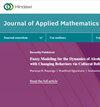Bifurcation Analysis of the Dynamics in COVID-19 Transmission through Living and Nonliving Media
IF 1.2
Q2 MATHEMATICS, APPLIED
引用次数: 0
Abstract
Transmission of COVID-19 occurs either through living media, such as interaction with a sufferer, or nonliving objects contaminated with the virus. Recovering sufferers and disinfectant spraying prevent interaction between people and virus become the treatment to overcome it. In this research, we formulate a new mathematical model as a three-dimensional ordinary differential equation system representing an interaction between viruses attached in nonliving media, susceptible, and infected subpopulations, including the treatment to investigate its effect. Disease-free, sterile-media endemic, and two nonsterile media endemic equilibriums exist in the model. The nonexistence of sterile-media equilibria interpreting the nonendemic condition is achieved by crossing the branch point bifurcation of the equilibria point as the infected subpopulation recovery rate increases. Continuation of the limit cycle generated at a Hopf bifurcation point as susceptible-coronavirus interaction prevention rate and period increase trigger two saddle-node bifurcations and a branch point bifurcation of cycle. Stable symmetric cycles with decreasing amplitude that make the dynamic of subpopulation easier to control start to be gained at the branch point bifurcation of cycle between the two saddle-node bifurcation points as the prevention rate increases. Some chaotic attractors which describe a complex and unpredictable pattern of the dynamic in the population are also found at inclination flip bifurcation by a continuation of a homoclinic orbit generated near the Bogdanov-Takens bifurcation point as the prevention rate increases while the recovery rate decreases. Increasing the recovery and prevention rate along with avoiding an increase of the prevention rate while the recovery rate decreases becomes the treatment to optimize the effort in overcoming COVID-19 transmission.COVID-19 在生物和非生物介质中传播的动力学分岔分析
COVID-19 的传播途径有两种,一种是通过活体媒介传播,如与患者接触,另一种是通过被病毒污染的非活体物体传播。让患者康复并喷洒消毒剂防止人与病毒之间的相互影响,是克服病毒传播的治疗方法。在这项研究中,我们建立了一个新的数学模型,它是一个三维常微分方程系统,代表了附着在非生物介质中的病毒、易感人群和感染亚人群之间的相互作用,包括研究其效果的治疗方法。模型中存在无病平衡、无菌介质流行平衡和两个非无菌介质流行平衡。随着受感染亚群恢复率的增加,通过跨越平衡点的分叉点,可解释非流行条件下不存在无菌介质平衡。随着易感者-冠状病毒相互作用预防率和周期的增加,在霍普夫分岔点产生的极限循环会继续,引发两个鞍节点分岔和一个循环分支点分岔。随着预防率的增加,在两个鞍节点分叉点之间的循环支点分叉处开始出现振幅递减的稳定对称循环,使亚群的动态更容易控制。随着预防率的增加和恢复率的降低,在波格丹诺夫-塔肯斯分岔点附近产生的同次轨道的延续,在倾斜翻转分岔点也会发现一些描述种群动态的复杂和不可预测模式的混沌吸引子。在提高恢复率和预防率的同时,避免预防率上升而恢复率下降,是克服 COVID-19 传播的最佳方法。
本文章由计算机程序翻译,如有差异,请以英文原文为准。
求助全文
约1分钟内获得全文
求助全文
来源期刊

Journal of Applied Mathematics
MATHEMATICS, APPLIED-
CiteScore
2.70
自引率
0.00%
发文量
58
审稿时长
3.2 months
期刊介绍:
Journal of Applied Mathematics is a refereed journal devoted to the publication of original research papers and review articles in all areas of applied, computational, and industrial mathematics.
 求助内容:
求助内容: 应助结果提醒方式:
应助结果提醒方式:


